Improving your posture can definitely help with your look and confidence, but it’s even much more than that. Having a good posture helps develop strength, balance and flexibility in your body. It can also reduce your risks of injury, and of developing muscle pain.
Here are 12 easy exercises that can get you started on improving your posture.
1. Child’s Pose
Child’s pose stretches and lengthens your spine, glutes, and hamstrings. It may also release tension in your lower back and neck.
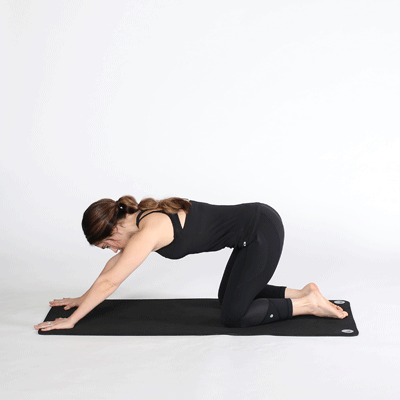
To do this pose:
- Sit on your shins with your knees together, your big toes touching, and your heels splayed out to the side.
- Fold forward at your hips and walk your hands out in front of you.
- Sink your hips back down toward your feet. If your thighs won’t go all the way down, place a pillow or folded blanket under them for support.
- Gently place your forehead on the floor or turn your head to one side.
- Keep your arms extended or rest them along your body.
- Breathe deeply into the back of your rib cage and waist.
- Relax in this pose for up to 5 minutes while continuing to breathe deeply.
2. Forward fold
This standing stretch releases tension in your spine, glutes, and hamstrings. It also stretches your hips and legs.

To do this pose:
- Stand with your big toes touching and your heels slightly apart.
- Bring your hands to your hips and fold forward at your hips.
- Release your hands toward the floor or place them on a block. Don’t worry if your hands don’t touch the ground — just go as far as you can.
- Bend your knees slightly, soften your hips, and allow your spine to lengthen.
- Tuck your chin into your chest and allow your head to fall heavy to the floor.
- Remain in this pose for up to 1 minute.
3. Cat-Cow
Cat-Cow pose helps relieve tension in your torso, shoulders, and neck while promoting blood circulation and spinal mobility.

To do this pose:
- Come onto your hands and knees with your weight balanced evenly between all four points.
- Inhale to look up, dropping your abdomen down toward the ground as you extend your spine.
- Exhale and arch your spine toward the ceiling and tuck your chin into your chest.
- Continue this movement for at least 1 minute.
4. Standing Cat-Cow
A variation on the standard Cat-Cow, this standing posture helps loosen up tightness in your back, hips, and glutes.
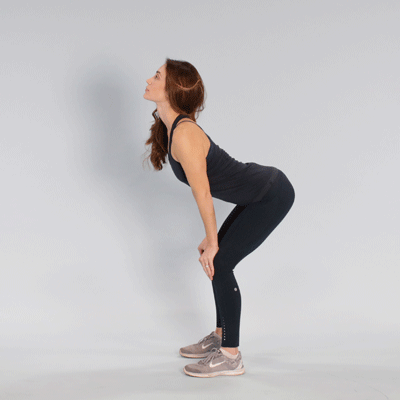
To do this pose:
- Stand with your feet about hip-width apart with a slight bend in your knees.
- Extend your hands in front of you or place them on your thighs.
- Lengthen your neck, bring your chin toward your chest, and round your spine.
- Then look up, lift your chest, and move your spine in the opposite direction.
- Hold each position for 5 breaths at a time.
- Continue this movement for a few minutes.
5. Chest opener
Opening and stretching your chest is especially useful if you spend most of your day sitting, which tends to make your chest move inward.

To do this stretch:
- Stand with your feet about hip-width apart.
- Bring your arms behind you and interlace your fingers with your palms pressing together. Grasp a towel if your hands don’t reach each other.
- Keep your head, neck, and spine in one line as you gaze straight ahead.
- Inhale as you lift your chest toward the ceiling and bring your hands toward the floor.
- Breathe deeply as you hold this pose for 5 breaths.
- Release and relax for a few breaths.
- Repeat at least 10 times.
6. High plank
High planks help relieve pain and stiffness throughout your body while strengthening your shoulders, glutes, and hamstrings. They also help develop balance and strength in your core and back, both important for good posture.
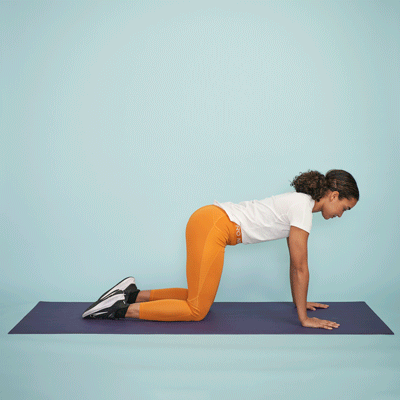
To do this exercise:
- Come onto all fours and straighten your legs, lift your heels, and raise your hips.
- Straighten your back and engage your abdominal, arm, and leg muscles.
- Lengthen the back of your neck, soften your throat, and look down at the floor.
- Make sure to keep your chest open and your shoulders back.
- Hold this position for up to 1 minute at a time.
7. Side plank
A variation on the standard plank, this move works the muscles in your sides and glutes. Strengthening and aligning these muscles helps support your back and improve posture.
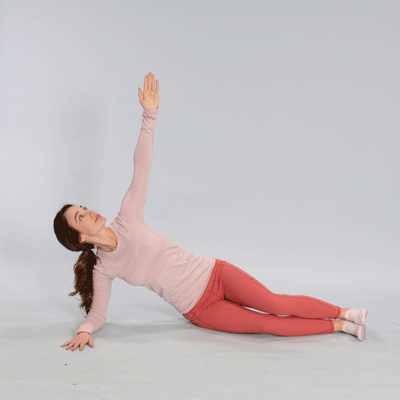
To do this exercise:
- From a high plank position, bring your right hand slightly in to center.
- Shift your weight onto your right hand, stack your ankles, and lift your hips.
- Place your left hand on your hip or extend it up toward the ceiling.
- You can drop your right knee down to the floor for extra support.
- Engage your abdominals, side body, and glutes as you maintain this pose.
- Align your body in a straight line from the crown of your head to your heels.
- Look straight ahead of you or up toward your hand.
- Hold this pose for up to 30 seconds.
- Repeat on the opposite side.
8. Downward-Facing Dog
Downward-Facing Dog is a forward bend that can be used as a resting pose to balance out the body. It can help relieve back pain, while also strengthening and aligning your back muscles.

To do this pose:
- Lying with your stomach on the floor, press into your hands as you tuck your toes under your feet and lift your heels.
- Lift your knees and hips to bring your sitting bones up toward the ceiling.
- Bend your knees slightly and lengthen your spine.
- Keep your ears in line with your upper arms or tuck your chin all the way into your chest.
- Press firmly into your hands and keep your heels slightly lifted.
- Remain in this pose for up to 1 minute.
9. Pigeon Pose
This hip-opening posture can also loosen up your spine, hamstrings, and glutes.
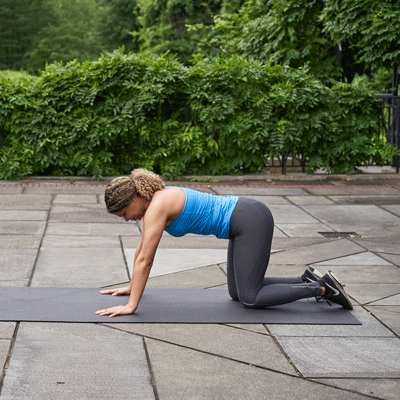
To do this pose:
- Come down on all fours with your knees below your hips and your hands a little bit in front of your shoulders.
- Bend your right knee and place it behind your right wrist with your right foot angled out to the left.
- Rest the outside of your right shin on the floor.
- Slide your left leg back, straighten your knee, and rest your thigh on the floor.
- Make sure your left leg extends straight back (and not to the side).
- Slowly lower your torso down to rest on your inner right thigh with your arms extended in front of you.
- Hold this position for up to 1 minute.
- Slowly release the position by walking your hands back toward your hips and lifting your torso.
- Repeat on the opposite side.
10. Thoracic spine rotation
Gently opening the chest and rotating the spine relieves tightness while increasing stability and mobility.
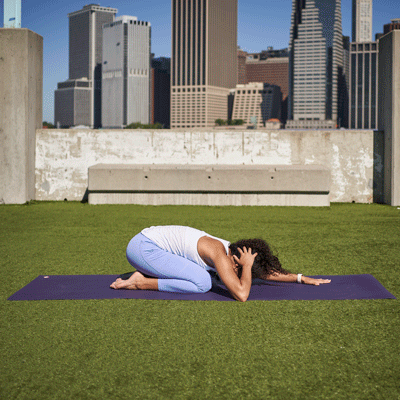
To do this stretch:
- Come onto all fours and sink your hips back down to your heels and rest on your shins.
- Place your right hand behind your head with your elbow extended to the side.
- Keep your left hand under your shoulder or bring it to center and rest on your forearm.
- Exhale as you rotate your right elbow up toward the ceiling and stretch the front of your torso.
- Take one long inhale and exhale in this position.
- Release back down to the original position.
- Repeat this movement 5–10 times, alternating sides.
11. Glute bridge
Glute bridges help strengthen and activate your glutes while relieving lower back pain. This improves the functioning and alignment of your hips and pelvis, leading to better posture.
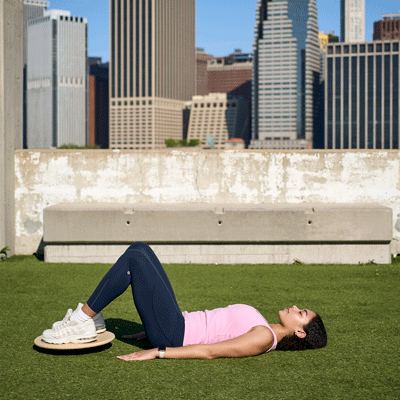
To do this exercise:
- Lie on your back with your knees bent and your feet about hip-distance apart.
- Keep your feet about a foot away from your hips.
- Rest your arms alongside your body with your palms facing down.
- Exhale as you lift your hips toward the sky, straightening your spine.
- Hold this position for up to 1 minute at a time.
12. Isometric pulls
Isometric pulls work your shoulder, arm, and back muscles, giving you the strength to maintain good posture.
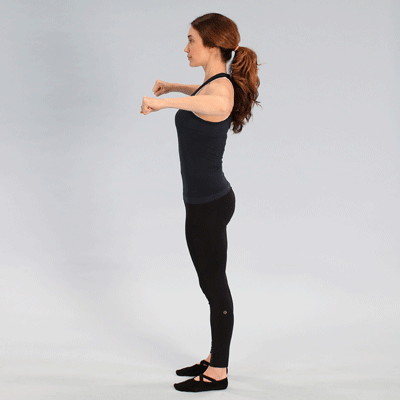
To do this exercise:
- Sit in a chair with a soft back.
- Make a fist with each hand and extend your arms in front of you so that they’re parallel to the floor.
- Exhale as you draw your elbows back toward your shoulders and squeeze your shoulder blades together.
- Breathe deeply as you hold this position for 10 seconds.
- On an inhale, slowly release to the starting position.
- Repeat this movement for 1 minute.
Frequently asked questions
Can you correct years of bad posture?
It’s possible to make improvements, but it’s important to manage expectations. Change won’t happen overnight.
If you aren’t noticing progress after a few weeks of consistent stretching and intentional practice, consult with a healthcare professional. They might recommend x-rays to examine the shape and alignment of your spine.
What exercise is the best at improving your posture?
The best exercise is one that you’re comfortable doing on a regular basis. This may mean trying a variety of different yoga postures, stretches, and other exercises designed to stretch and lengthen the spine.
Can you fix your posture in 30 days?
Many people see improvements within a couple of weeks, but it requires commitment and consistency.
What exercises fix slouching?
Paying attention to how you sit and how you stand is the best way to notice and correct slouching. Allowing your shoulders to relax and pull back slightly can help with rounding or a hunched-over stance.
You might find it helpful to imagine an invisible piece of string gently pulling your head toward the ceiling. Your head should be level with your ears over your shoulders.
The bottom line
Building and maintaining good posture requires a mix of muscle strength, joint mobility, and overall balance. Staying active, practicing body awareness, and wearing supportive shoes can help.
If you usually spend a lot of time sitting, you might find it helpful to modify your space to be more ergonomic. Finding ways to work in more movement, like walking around the room at the top of the hour, may also be beneficial.
DISCLAIMER: These posts should not be used to self-diagnose or self-treat any health, medical, physical or psychiatric condition. Information shared via posts does not replace professional healthcare advice specific to your condition and needs. If you are unsure whether you would benefit from implementing tools discussed in these posts, please contact your healthcare provider.